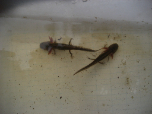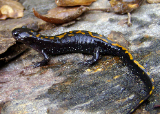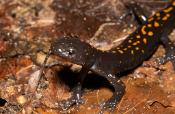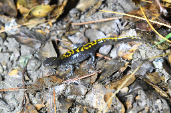Santa Cruz Long-Toed Salamander (A. m. croceum)
Description: It has a black body, broken yellow or orange irregular striping along its spine, and a tail fin well evolved for swimming. Like other mole salamanders, it is found near pools or slow-moving streams and has a very secretive lifestyle, making it difficult to find. The Santa Cruz long-toed salamander has an irregular broken yellow stripe on its back, whereas the common long-toed salamander has a more regular yellow, vertical stripe.
Habitat: Coastal woodland and chaparral near ponds and marshes used for breeding. Shade and abundant soil humus are prime requirements. Spends most of time underground in animal burrows or in spaces among root systems of woody plants. Breeds in shallow ponds with abundant submerged vegetation; ponds fill in winter and spring, dry by late summer, must hold water for at least 90 days. Eggs are laid on submerged stalks of spike rush or similar aquatic plants.
Range: This subspecies is endemic to California, inhabiting a very limited range with scattered populations in a reported 11 locations around the coast of Monterey Bay in southern Santa Cruz County and the northern edge of Monterey County. It is thought to be a relict population, now isolated from the rest of its species.
Found in these States:
CA
Diet: Carnivorous. Transformed adults eat small invertebrates, including worms, mollusks, insects, and spiders. Larvae start by eating small crustaceans. As they increase in size, they gradually consume larger prey items, including crustaceans, worms, mollusks, and frog tadoles. Larger larvae may cannibalize smaller larvae. Young larvae feed by sitting and waiting for prey, while larger larvae also stalk and pursue prey.
Reproduction: Mating reaches peak in January-February, when heavy rains have filled breeding ponds. Eggs hatch in about a week; larvae metamorphose in 90 to 140 days, depending on temperature, then leave pond. Sexually mature in 3 to 4 years, before which the young do not return to the breeding pond.
Status: Ambystoma macrodactylum croceum was designated as federally endangered in 1967 under the Endangered Species Preservation Act (a precursor to the Endangered Species Act of 1973), and endangered by the State of California in 1971;. It has also been designated as Critically imperiled at the global and state level by NatureServe. Its limited range and fragile specialized habitat place severe restrictions to the viability of this species. There is no definitive population estimate for the Santa Cruz long-toed salamander, but the numbers are deemed to be quite small. Further disturbance of its limited habitat could lead to this species' extinction.
»» Kingdom: Animalia - Animals
»» Phylum: Chordata - Chordates
»» Subphylum: Vertebrata - Vertebrates
»» Class: Amphibia - (Amphibians)
»» Order: Caudata - Salamanders
»» Family: Salamandridae - Newts
»» Subfamily: Pleurodelinae - Pleurodeline Newts
»» Genus: Ambystoma
»» Species: Ambystoma macrodactylum - Long-Toed Salamanders
»» Subspecies: A. m. croceum - Santa Cruz Long-Toed Salamander
This article uses material from the Wikipedia article "Santa Cruz Long-Toed Salamander", which is released under the Creative Commons Attribution-Share-Alike License 3.0. Content may have been omitted from the original, but no content has been changed or extended.
|













